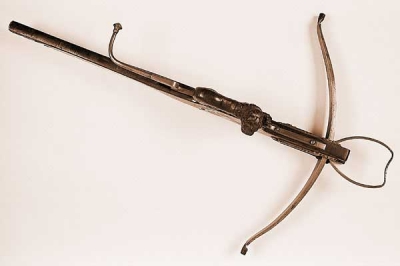Crossbow (1884.16.16)
 ItalyCrossbow from Italy, Europe. Part of the Pitt Rivers Museum Founding Collection. Given to the Museum in 1884.
ItalyCrossbow from Italy, Europe. Part of the Pitt Rivers Museum Founding Collection. Given to the Museum in 1884.
This crossbow has a massive steel bow, revolving nut release and a long slender stock (body). This is a very powerful weapon with a draw weight of over 700 lbs - far to much to be drawn by hand. So sitting on top of the stock is a windlass or moulinet, which draws the bow using a mechanism fixed to the butt with rotary handles.
The Museum's original entry for this crossbow describes it of being of the late 15th or early 16th century and from Genoa, Italy. However, more recent scholars have found that such windlass-spanned crossbows, although attributed to the medieval period, were actually only used from the 16th century onwards and, more confusing still, that there was a fashion among antiquarian replica-makers of the 18th and 19th centuries for making such weapons, particularly in Belgium, the Netherlands and Germany.
These findings make it very difficult to pinpoint the origin of this weapon with accuracy although, admittedly, certain metal parts of the bow (the foot-stirrup and the extension hand-grip under the stock) do seem rather 'fresh' for a 500-year-old weapon. Similarly, the inlaying of bone or ivory plaques (there is an image of a heraldic lion on the side of the stock, not visible in the photograph), suggests a North European provenance rather than a Southern one. Finally, it is well known that many such weapons were accorded a Genoese provenance due to the famous reputation of that city's crossbowmen since the time of the Crusades. All these elements considered, it is quite likely that this crossbow is in fact a (very high quality) Victorian replica.





